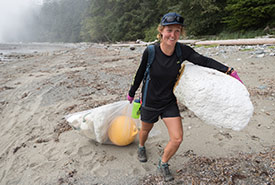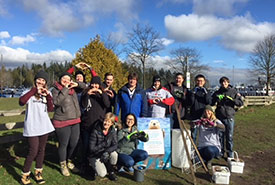Bringing communities together: The Great Canadian Shoreline Cleanup

Hauling foam, a buoy and other marine debris during a 2016 Great Canadian Shoreline Cleanup. (Photo courtesy of Rachel Schoeler)
As an avid open water swimmer, I learned to respect our waterways while fighting through the smack and splash of ocean waves during long training swims. I fell in love with our waterways during calm, quiet morning swims out on the lake. And I became driven to fight for the health of our waterways because of all that they offered me — mentally, physically, emotionally, culturally and socially. In both my personal life and work, I have also been truly inspired by the positive impact each person can have on their environment; this is what keeps me going every day.
The Great Canadian Shoreline Cleanup is a conservation partnership by Ocean Wise and WWF-Canada that aims to build an understanding of shoreline litter by encouraging Canadians to rehabilitate their shorelines through cleanups. Each year, we engage with tens of thousands of Canadians across the country who lead or join shoreline cleanups anywhere that land connects to water, including ocean beaches, lakes, streams, creeks, storm drains and school yards.

Great Canadian Shoreline Cleanup participants show their love for Canada's shorelines after a day of hard work (Photo courtesy of GCSC)
Volunteers from schools and youth service agencies, workplace and government groups, community groups, conservation organizations and concerned citizens join together to lead shoreline cleanups to play a role in protecting their local shorelines. They come from all walks of life and play a very important role in bringing their community together, raising awareness and building an understanding of the immediate threats to their local shorelines. It’s absolutely incredible.
To make things even more amazing, all of the volunteers who participate in the Great Canadian Shoreline Cleanup are citizen scientists. They track and submit data on what they find during their cleanups. By using our data cards to track the types of litter picked up, volunteers contribute to national and international databases that help us better understand the sources and impacts of shoreline litter across Canada and around the world.
Each year, we share the results for our annual “Dirty Dozen” list, which includes the top 12 litter items found on Canadian shorelines. Topping the list in 2017, with over 330,000 pieces collected, were tiny pieces of plastic and foam (less than 2.5 centimetres in length). The next culprits were cigarette butts, plastic bottles and food wrappers. Seeing tiny pieces of plastic and foam at the top of the list highlights that even the smallest pieces of litter can have a big impact.

Graphic courtesy of Great Canadian Shoreline Cleanup
Year after year, the Dirty Dozen list sparks important conversations about what can be done to reduce the amount of litter we find on our shorelines. Data collected by Shoreline Cleanup volunteers over the past 25 years can be used by municipalities, students and concerned citizens to push for real change in their community. Want to know how you can use this data in your community? Check out this webinar for more details and get inspired by some volunteers who have already put this data to work.
As a community, we must continue to stand up for our shorelines and natural places. An easy way to make a meaningful contribution is to practice the four Rs and remember their order: refuse, reduce, reuse, recycle.
Volunteerism is required on both lands and waters already protected and conserved in our communities as well as public places. You can take part, in a meaningful way, with a Nature Conservancy of Canada Conservation Volunteers event or a Great Canadian Shoreline Cleanup. These programs require public support to achieve a collective goal of a clean and healthy environment.
Please visit shorelinecleanup.ca to learn more about how to lead or join a shoreline cleanup in your community. See you on your shoreline soon!
Learn more about how NCC’s Conservation Volunteers are caring for Canada’s waterways.


